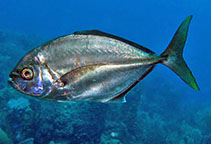| Family: |
Carangidae (Jacks and pompanos), subfamily: Caranginae |
| Max. size: |
50 cm TL (male/unsexed); max.weight: 2,040.0 g |
| Environment: |
pelagic-oceanic; marine; depth range 1 - 50 m, oceanodromous |
| Distribution: |
Worldwide in warm waters. Western Indian Ocean: Tanzania (Ref. 3287, 3197). Eastern Central Pacific: California, USA to Costa Rica (Ref. 2850). Also in Hawaii. Western Atlantic: Massachusetts, USA and northern Gulf of Mexico to Brazil. Eastern Atlantic: Mauritania to Angola (Ref. 7097); also Algoa Bay, South Africa (Ref. 3197). |
| Diagnosis: |
Dorsal spines (total): 9-9; Dorsal soft rays (total): 27-32; Anal spines: 3-3; Anal soft rays: 19-23. Adults dark to bluish black; juveniles with 6-7 dark bands with pale interspaces (Ref. 3197). |
| Biology: |
Adults are mostly oceanic and pelagic but sometimes found near the bottom, often near islands. Solitary or in small schools (Ref. 2850). |
| IUCN Red List Status: |
Least Concern (LC); Date assessed: 21 August 2012 Ref. (130435)
|
| Threat to humans: |
harmless |
Source and more info: www.fishbase.org. For personal, classroom, and other internal use only. Not for publication.

